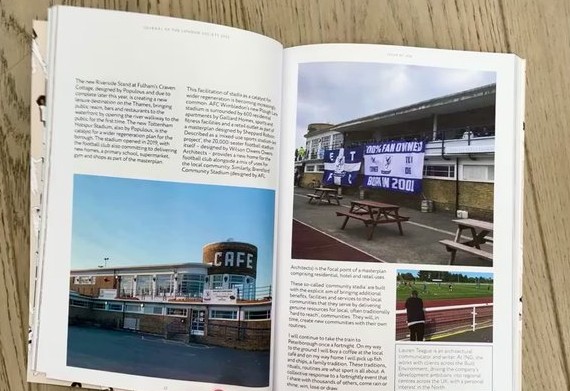Post
JOURNAL 2022 | Creating Community
5 Aug 2022
Journal 476 was published last month with its theme of Connections. (You can buy a copy here - 100 pages of top quality writing and photography, book reviews, reportage and London history.)
In this piece from the Journal, architectural writer Lauren Teague looks at the importance of football stadiums in creating community.
I was 11 days old when my dad first took me to London Road – the home of Peterborough United and now my ‘home’ too, for better or worse, every other Saturday. It’s not a modern ground, nor is it particularly glamorous, but walking through town from the station, over the bridge, and approaching the north-west corner of the ground along with 7- or 8,000 other like minded fans, you can’t help but feel part of something special. Anticipation. Excitement. Anxiety.
American geographer Yi-Fu Tuan explores the genius loci of place and its connection with human society – he calls this ‘topophilia’; a place that generates feelings of love or attraction. It was cultural geographer John Bale who likened this to the psychological attachment to football stadia. But it is not the architecture of the stadium alone that draws the masses to it, it’s the sense of routine – a shared ritual – that connects fans together to create community.
I didn’t choose my football club – it was a birthright, passed down through generations of Teagues. But when I moved to London in 2017, I did make a choice to adopt my local football club: Enfield Town FC. The 20-minute walk to the Queen Elizabeth II ground, with its art deco stand, gives me a new routine and a new community to be a part of: a home away from home that unites me not only with other supporters but with my new local area.
Non-league football in particular is known for drawing people together. Some of the supporters at Enfield Town are, of course, lifelong fans. Others, like me, have moved to the area and turn up to support their local club on the occasions that their ‘first team’ isn’t playing. Kids can run around the outside of the pitch while their parents watch the game. When everyone changes ends at half time, wry smiles are exchanged with the opposing fans. An unlikely group of people brought together for 90 minutes for a common purpose.
It can be difficult to explain to those ‘not into football’ how a group of players can bring together a few thousand strangers just by wearing a shirt with a team badge on it.
For fans, the sense of place gained from the participation in a shared routine manifests within the physical form of the stadium – an urban landmark implicated by its connection to a particular audience – the sports spectator.
Throughout historical precedence, the stadium has provided a bespoke arena for communal activity, but the role of the modern stadium goes beyond the sport itself to affect the wider urban environment. According to Bale, the stadium is a sports facility “that always generates both positive and negative effects on the broader urban community and the local/neighbourhood community as well as on fans”. So how does a sports stadium bene t those who don’t follow the team – those residents for whom match days are even deemed as a ‘nuisance’?
Modern stadia are not built in isolation. Increasingly, their role is one of a facilitator or a centrepiece within a wider masterplan that brings local benefits beyond the audience
of a team’s supporters. In London alone, the past few years have seen a number of new stadia built that have contributed more than just ‘a functional space for the production of football matches’, supporting communities with new facilities that would otherwise struggle to come forward.
The new Riverside Stand at Fulham’s Craven Cottage, designed by Populous and due to complete later this year, is creating a new leisure destination on the Thames, bringing public realm, bars and restaurants to the waterfront by opening the river walkway to the public for the first time. The new Tottenham Hotspur Stadium, also by Populous, is the catalyst for a wider regeneration plan for the borough. The stadium itself opened in 2019, with the football club also committing to delivering new homes, a primary school, supermarket, gym and shops as part of the masterplan.
This facilitation of stadia as a catalyst for wider regeneration is becoming increasingly common. AFC Wimbledon’s new Plough Lane stadium is surrounded by 600 residential apartments by Galliard Homes, sports and fitness facilities and a retail outlet as part of
a masterplan designed by Sheppard Robson. Described as a ‘mixed-use sports stadium-led project’, the 20,000-seater football stadium itself – designed by Wilson Owens Owens Architects– provides a new home for the football club alongside a mix of uses for
the local community. Similarly, Brentford Community Stadium (designed by AFL Architects) is the focal point of a masterplan comprising residential, hotel and retail uses.
These so-called ‘community stadia’ are built with the explicit aim of bringing additional bene ts, facilities and services to the local communities that they serve by delivering genuine resources for local, often traditionally ‘hard to reach’, communities. They will, in time, create new communities with their own routines.
I will continue to take the train to Peterborough once a fortnight. On my way
to the ground I will buy a coffee at the local café and on my way home I will pick up sh and chips, a family tradition. These traditions, rituals, routines are what sport is all about. A collective response to a fortnightly event that I share with thousands of others, come rain or shine; win, lose or draw.
You can get your copy of Journal 476 here.
